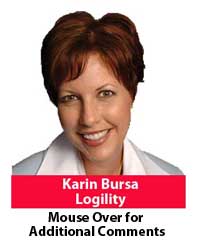A couple of months ago, SCDigest conducted a virtual panel with a number of experts on trends and insights relative to supply chain execution technologies that proved very popular with our readers. See Key Trends in WMS and Supply Chain Execution Technology.)
We've now repeated the concept with a fantastic virtual panel of experts on supply chain planning software and practices.
Those include:
David Johnston, Senior Vice President for Supply Chain at JDA Software
Karin Bursa, Vice President of Marketing at Logility
John Bermudez, Vice President of Product Management at Infor
Lisa Kustra, Founder, Plan4Demand
Mark David, Vice President of Solution Management for Supply Chain Planning at SAP
SCDigest Says: |
 Johnston says a few leaders are starting to "Connect their supply chains and in a way that provides a cross enterprise 'sandbox' environment to conduct accurate what-if simulations to assess and propose changes to end-to-end strategies." Johnston says a few leaders are starting to "Connect their supply chains and in a way that provides a cross enterprise 'sandbox' environment to conduct accurate what-if simulations to assess and propose changes to end-to-end strategies."

Click Here to See Reader Feedback
|
Plan4Demand is a consulting firm focused on supply chain planning. All the other companies are providers of supply chain planning software, also sometimes referred to as Advanced Planning Systems (APS). The participants were selected by SCDigest for their known expertise in this area.
We first asked the panel what were some of the key trends in supply chain planning technology and its use by companies.
"We see a renewed focus among supply chain organizations on demand planning and market segmentation," said Bursa. "As part of this, companies want to improve their forecast accuracy at more granular levels, understanding this is a pivotal key performance indicator that drives value throughout the supply chain. Analysts have discussed and we have seen how a 5% improvement in forecast accuracy can drive double digit improvements in service levels virtually for free."
JDA's Johnston sees a lot of action in so-called "supply chain segmentation" strategies, as he explains.
"This is about segmenting supply chains into multiple virtual supply chains to develop tailored end-to-end supply chain processes to support distinctly different segments of the business," he told us. "Companies are tailoring their demand management process, production methods, inventory strategies, distribution paths and transportation modes to the distinct characteristics of the products, customer and channels that they serve."
Kustra says companies are using technology to compensate for lean staffing, noting that one key trends is renewed focus on demand classification and statistical forecasting, in part because most companies do not staff enough demand planners these days to keep the number of SKUs they need to forecast at a level that they can manage effectively.
"Demand classification can help the planners understand high priority items," Kustra told us. "The high volume/high variability items are the most critical ones to handle when they show up on exception reports. The key to demand classification is that the logic/criteria of the ABC analysis are agreed upon between not only people in the supply chain but also sales and marketing and finance to avoid the 'HALO effect' on products that were once fast movers but no longer are. The data will clearly show what products are critical to look at in detail and what products are not."
Infor's Bermudez says layering advanced analytics on top of supply chain planning tools is a key trend.
 "While supply chain planning applications have been the backbone of a lot of the analysis that managers have used to make critical decisions, they only provide one piece to the planning puzzle," he says. "While supply chain planning applications have been the backbone of a lot of the analysis that managers have used to make critical decisions, they only provide one piece to the planning puzzle," he says.
"More and more, we are talking to managers that want analytical tools that elevate the decision making above demand and supply planning in order to determine the impact on revenue and profitability," he said.
What they are really looking for, he says, is Integrated Business Planning (IBP), a sort of more advanced form of Sales & Operations Planning that brings associated financial targets more directly into the process.
"This process essentially validates that operating plan is able to achieve the financial objectives set by the executive team," Bermudez says, "While this may sound like motherhood and apple pie, most manufacturing companies simply do not have the planning tools to achieve this level of synchronization. A good IBP application provides this by combining an analytical platform with the supply chain planning and scheduling applications."
SAP's David sees resurgent interest in supply chain planning, and he, like several other panelists, also sees strong interest in S&OP.
 "We are really seeing the heat get turned up on supply chain planning again," David says. "This is coming from a couple of areas, including a more dedicated focus on managing business planning, where the alignment between business priorities and operational decisions get balanced with a clear understanding of financial impact. Yes, this is Sales and Operations planning, but S&OP is no longer such a separate process without direct connection to the operational plan." "We are really seeing the heat get turned up on supply chain planning again," David says. "This is coming from a couple of areas, including a more dedicated focus on managing business planning, where the alignment between business priorities and operational decisions get balanced with a clear understanding of financial impact. Yes, this is Sales and Operations planning, but S&OP is no longer such a separate process without direct connection to the operational plan."
Kustra also says there is a trend towards more companies looking to better connect demand planning to master planning and centralizing the master planning process to better maximize plant capacity, including raw materials, machinery and labor utilization.
Johnston like Kustra also sees a trend towards supply chain technology helping to overcome staffing limitations.
"Companies are leveraging advanced analytics and automated decision making to provide scale in their organization and reduce the skill levels needed to leverage the supply chain as a competitive differentiator," he says.
David says "big data" and related analytic tools are also a major trend.
(Supply Chain Trends and Issues Article - Continued Below)
|